#ancient chinese landscape painting
Explore tagged Tumblr posts
Text

Dragon of the Yellow Mountains 🐉🏔️
The dragons of China were benevolent, peaceful beings unlike their Western counterparts. The most revered of them all, the celestial yellow dragon, was said to bring good fortune and power.
In this painting I imagined the yellow dragon gliding through the majestic Huangshan, or yellow mountains, on its way to ascend to the heavens. A incredibly rare and fortunate sight to behold!
Really proud of this piece, it was definitely a fun experiment with textures and light.
#fantasy#illustration#fantasy character#artwork#digital art#digital painting#chinese dragon#chinese art#chinese#chinese mythology#mythology#asian mythology#asian dragon#asian#asia#china#ancient china#dragon#dragon art#landscape#mountains#mountainscape#fantasy art#concept art#folklore#asian folklore#texture#digital arwork#procreate#painting
116 notes
·
View notes
Text
ancient China landscape bird drawing washi tape
#ancient china#chinese painting#chinese art#chinese poetry#bird drawing#chinese bird painting#ink painting#landscape ink painting#forest painting#asian fine art
1 note
·
View note
Text

Chinese ink brush painting, ancient Chinese lady, cherry blossoms, crane, and landscape. . . . #ancientchina #ancienttattoo #chinesestyle #chinesestyletattoo #cherryblossom #plumblossom #peachblossom #cherryblossomtattoo #cranetattoo #landscapetattoo #chinesepaintingtattoo #asianinkandart #instattoo #instatattoo #hktattooartist #hktattoostudio #tattoohk #hktattoo #hongkongtattoo #紋身 #香港紋身 #刺青 #水墨 #水墨画 #水墨刺青 #ダトゥー #入れ墨 #수묵화 #수묵화타투 #벚꽃타투
#Chinese ink brush painting#ancient#Chinese lady#cherry blossoms#crane#and landscape.#ancientchina#ancienttattoo#chinesestyle#chinesestyletattoo#cherryblossom#plumblossom#peachblossom#cherryblossomtattoo#cranetattoo#landscapetattoo#chinesepaintingtattoo#asianinkandart#instattoo#instatattoo#hktattooartist#hktattoostudio#tattoohk#hktattoo#hongkongtattoo#紋身#香港紋身#刺青#水墨#水墨画
0 notes
Text
Amazing fanart by Joanacchi! Posted here on tumblr with their blessing. Each one is based on a style that reflects a particular ancient culture's art history. (See below for descriptions provided by the artist!)
Store (buy these prints!) Twitter Instagram

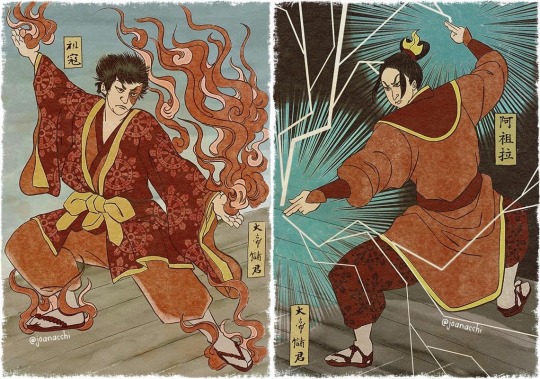
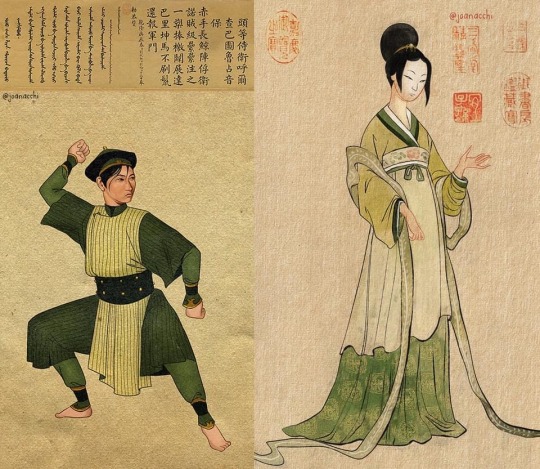
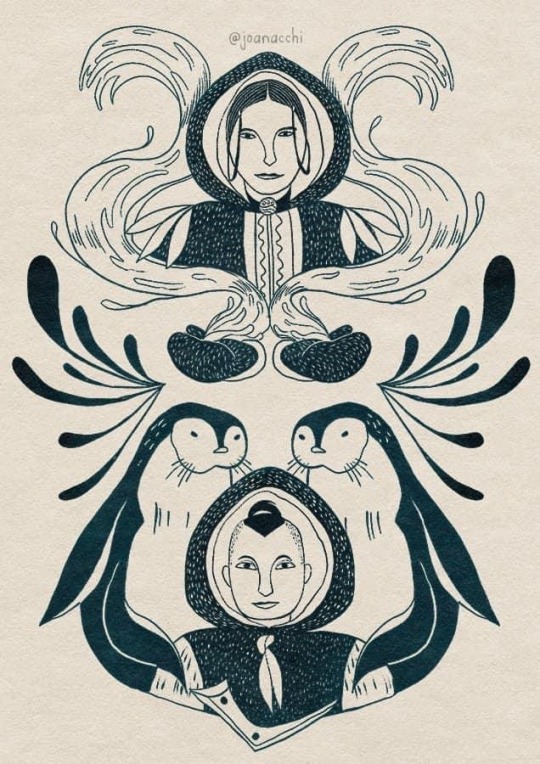
Aang: Tibetan Thangka
"Thangkas are traditional Tibetan tapestries that have been used for religious and educational purposes since ancient times! The techniques applied can vary greatly, but they usually use silk or cotton fabrics to paint or embroider on. What you can depict in a Thangka is really versatile, and I wanted to represent things that make up Aang as a character."
Zuko and Azula: Japanese Ukiyo-e
"Ukiyo-e is a style that has been around Japan between the 17th and 19th century, and focused mainly in representing daily life, theater(kabuki), natural landscapes, and sometimes historical characters or legends!
Ukiyo-e was developed to be more of a fast and commercial type of art, so many drawings we see are actually woodblock prints, so the artist could do many copies of the same art!
I based my Zuko and Azula pieces on the work of Utagawa Kuniyoshi (1798-1861) one of the last ukiyo-e masters in Japan! He has a specific piece which featured a fire demon fighting a lord that fought back with lighting, and that really matched Zuko and Azula's main techniques!”
Toph: Chinese Portraiture from Ming and Qing Dynasties
"Ming Dynasty (1368-1644) was one of the longest in China! It was also a period where lots of artistic evolutions were happening, especially when it comes to use of colour! There was not a predilection for portraits during this time, but there are a lot of pieces depicting idealized women and goddesses from the standards of the time. For this portrait of Toph, I imagined something that maybe their parents commissioned, depicting a soft and delicate Toph which we know is not what she is about ♥️
Qing Dynasty (1644-1912) was the last Chinese Dynasty to reign before the Revolution. One of the most famous emperors of this period was Qianlong, and he really liked Western art! He commissioned a lot of portraits of his subordinates, and I chose a portrait of one of his bodyguards as a reference for the second Toph portrait, which I believe is much more like how she would want to be represented! The poem on top talks about the bodyguards' achievements during a specific war. I had no time to come up with a poem for Toph, so I just used the same one for the composition!”
Sokka and Katara: Inuit Lithograph
"For a long time, Inuit art expressed itself in utilitarian ways. The Nomadic lifestyle of early Inuit tribes played a huge part in that: most art pieces are carved in useful tools, clothing, or children's toys, small and easy to be transported, and depicted scenes and patterns representing their daily lives!
That changed a lot during the colonization. Since the settling of the Inuit tribes, many art pieces began to be created in order to be exported to foreigns, so they started to sculpt bigger and more decorative pieces.
Lithography, which is a type of printmaking, was introduced to Inuit people by James Houston, that learned the technique from the japanese. The art form was quickly embraced by the inuit, as part of the process is very similar to carving. Prints that are produced by inuit artists are still being sold today!
As lithography is not an old art style and it's still commercially relevant to the Inuit communities, since creating these in 2021 I have been donating regularly to the Inuit Art Foundation, not only all the money I get from selling some prints of these but a bit more, at least once a year. Hopefully, I can increase donations this year!”
702 notes
·
View notes
Text

MWW Artwork of the Day (1/20/24) Zhao Mengfu (Chinese, 1254–1322) Bathing Horses (c. 1295-1305) Detail of hanging scroll, 28.1 x 155.5 cm. Palace Museum, Beijing
Zhao Mengfu’s paintings were among the first after the collapse of the Song dynasty and its academy of painting to show an interest derived from subjects and styles of ancient masters. Zhao is popularly remembered as a painter of horses in the manner of the Tang dynasty (618–907) master Han Gan, but he also painted other animal groups, landscapes, and bamboos. Referring to the antique, he generally avoided superficial beauty by utilizing deliberately simplified color and compositions and a schematic, even childlike, rendering of forms and scale. His works often display a great variety of brushwork.
8 notes
·
View notes
Text
China Post-Rock GO! serial tour,presented by 1724 Records

The Beijing based label, 1724 Records, has steadily been building its fanbase and roster for over fifteen years, focusing on post-rock and ambient music. Unsung and steadfast heroes, they’re going all out with a two night gathering of post rock’s longest standing acts from all across China.
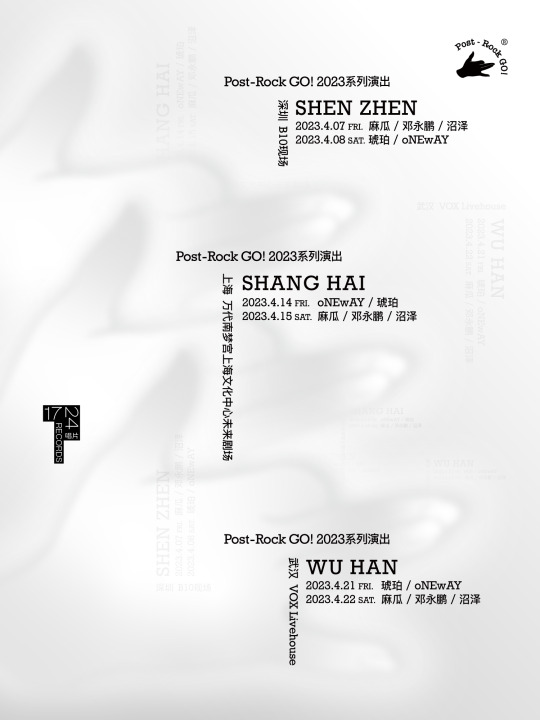
Night one features Kunming based oNEwAY, who started out twenty years ago and have integrated more and more Chinese folk music in their sound. They will join Xi’an heavyweights Amber, whose low-key, slow-burning sound has never sounded better - finding ways to shake up their arrangements with math rock flourishes, ambient electronica, heightened Britpop aplomb, and of course, soaring, ‘bursting at the seams’ crescendos that the genre is so well known for. Post rock heaven.
Night two features Guangzhou juggernauts Zhaoze, whose distinct and definitive guqin-laced post-rock is transcendent. They join Zhangjiajie’s Muggle, who bring an atmospheric mountain-esque beauty to their delicate sound, and Deng Yongpeng, whose seemingly minimalist piano instrumental music has taken on new forms over the years
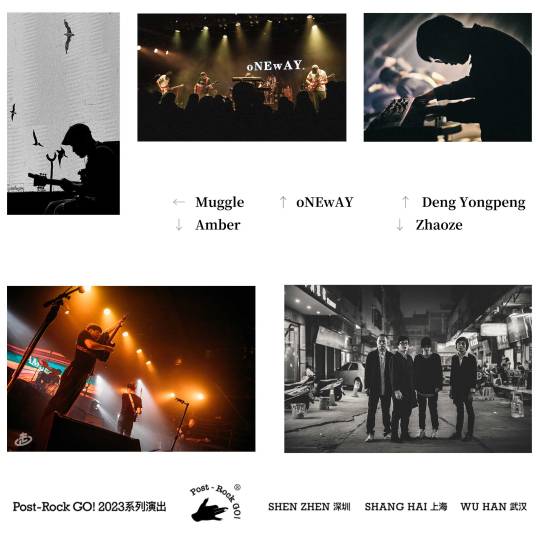
Amber Amber's music is one of the few things in the world where cold and warm coexist. Formed in the ancient city Xi 'an in 2010, Amber has graciously displayed such imprints in their albums. With a clear and bright timbre that blends traditional spirit and contemporary charm with iconic melodies, Amber is a name you'd love to hear in a post-rock band.
oNEwAY The band started in 2003 or earlier by Wangwei, in Kunming, Yunnan. The band took shape on National Day in 2006. They have melodies and soundscapes that you can indulge in. At present, oNEwAY puts its creative direction under the framework of instrumental music and post-rock and focuses on the experiment and exploration of organic integration of Chinese folk music elements and modern music elements, and in the future, it will be much more than that.
Muggle
Muggle is a music project that began in Zhangjiajie, a small city in western Hunan Province, China, with compositions involving elements such as post-rock and ambient.
Muggle was nominated for Record of the Year by Abilu Music Awards and featured by Apple Music. It is called "dreamy, even dazzling" by music critics both at home and abroad.
Deng Yonpeng
In addition to being the keyboardist of the band Summer Fades Away, Deng Yongpeng is also an excellent piano player and creator.
The project all began in his youth, accompanied by the noise of factories, nurtured in the streets of Changsha, and was gathered in 2014 because of the album If Changsha is What You Imagine, then I was Never Here. The album includes 5 original minimalist piano pieces, about the glory of youth passing away, but also another voice away from the noise. It was released by 1724 Records.
Deng Yongpeng's work continues.
Zhaoze
Zhaoze has a genre of its own. In 2006, Zhaoze began to explore the integration of the ancient Chinese musical instrument - guqin and gradually developed a paradigm of Guqin and rock. Zhaoze, in its unique way, integrates guqin and rock so thoroughly and comprehensively, infusing the sketching and feelings like Chinese landscape painting into their music.
"Zhaoze is China's Pink Floyd," says Christoph Borkowsky, founder of WOMEX in Berlin. Rockaxis Colombia named the Zhaoze South American Premiere one of the best performances of 2017, alongside such famous acts as U2 and Sigur Ros.
1724 Records https://1724records.com/ https://www.facebook.com/1724Records https://www.instagram.com/1724records/
2 notes
·
View notes
Text
CHINESE ART :
Travelers Among Mountains and Streams by Fan Kuan. (Early 11th century)

• Fan Zhongzheng better known by his pseudonym Fan Kuan Chinese: 范寬, was a Chinese landscape painter of the Song dynasty.
• Widely considered one of the great masterpieces of Chinese landscape painting (in Chinese, literally “Mountain and Water Painting”), Fan Kuan’s Travelers influenced countless generations of painters and still impresses viewers to this day with its sublime depiction of nature. The story goes that Fan Kuan took to the depths of the mountains to observe and learn from nature, and thereby transmitted the spirit of the mountains with his brush. Whether true or not, at nearly seven feet tall, the monumental hanging scroll painting lends credibility to the story. The painter used a tripartite division of the composition into near, middle and deep distance and shifted the weight to the deep space at top so that mountains loom over the travelers on a rocky path below, as well as over any viewer standing in front of the painting.
• Travelers among Mountains and Streams, a large hanging scroll, is Fan Kuan's best known work and a seminal painting of the Northern Song school. It establishes an ideal in monumental landscape painting to which later painters were to return time and again for inspiration. The classic Chinese perspective of three planes is evident - near, middle (represented by water and mist), and far. Unlike earlier examples of Chinese landscape art, the grandeur of nature is the main theme, rather than merely providing a backdrop.
KOREAN ART :
Embrace by Min joung-ki. (1981)
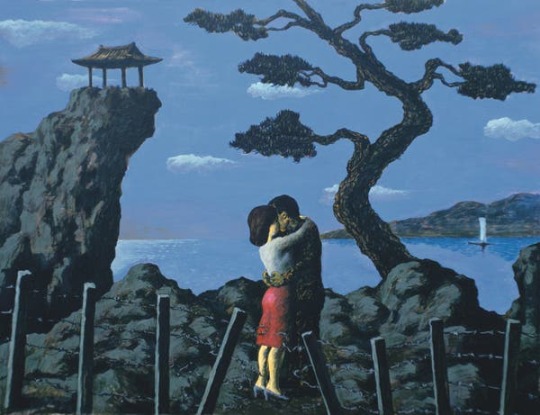
• In 1987, after moving from Seoul a yangpyeong in the province of Gyeonggi, began painting landscapes centered on mountains, ultimately defining his style of reinterpreting the everyday landscape in a way that emphasizes its realism and socio-political history. Although he has focused mainly on geographical features and human footprints left in nature, including mountains and water, his canvases indicate an approach towards urban environments and architecture, becoming a painter who merged his discipline with that of an urban planner. Over time, Min joung-ki he accentuated the location in his paintings, involving the historicity of each place and capturing each of its geological and geographical characteristics, defining its place in the guild. This approach to painting that calls it yinyeon, and he has achieved it through the memory of the roads on which he has walked. Through the use of oil painting and the grammar of Western painting, along with the map format, scenery and ancient screens, he has established his method of transmitting his interest in the intersection of place and time. For almost his entire career, and derived from what he has displayed on his canvases over the years, Min has often been dubbed a pioneer of art. minjung, a pro-democratic and populist art movement that prevailed in South Korea in the 1980s, but the artist has refused to be the main figure, however, due to his so-called "barber shop painting", which he created in protest of aesthetic rigorism, he has never been able to completely disassociate himself from this current of art.
• Min JoungKi is a Korean Asian Modern & Contemporary painter who was born in 1949. Numerous key galleries and museums such as Kunstmuseum Wolfsburg have featured Min JoungKi's work in the past.
JAPANESE ART :
The Breaking Wave off Kanagawa by Katsushika Hokusai (1831)
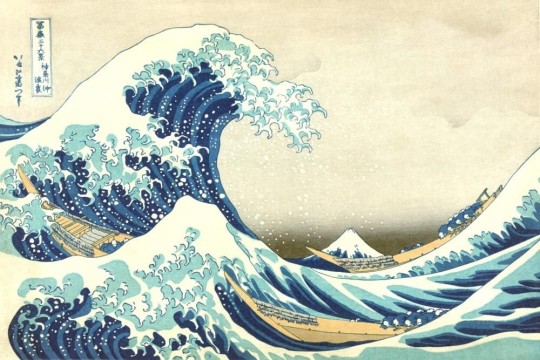
• is a woodblock print that was made by Japanese ukiyo-e artist Hokusai, probably in late 1831 during the Edo period of Japanese history. The print depicts three boats moving through a storm-tossed sea with a large wave forming a spiral in the centre and Mount Fuji visible in the background. The composition of The Great Wave is a synthesis of traditional Japanese prints and Western perspective, and earned him immediate success in Japan and later in Europe, where it inspired the Impressionists. Several museums throughout the world hold copies of The Great Wave, many of which came from 19th-century private collections of Japanese prints.
• The Great Wave off Kanagawa has been described as "possibly the most reproduced image in the history of all art", as well as being a contender for the "most famous artwork in Japanese history". It has influenced several notable artists and musicians, including Vincent van Gogh, Claude Debussy, Claude Monet, and Hiroshige.
• Katsushika Hokusai known simply as Hokusai, was a Japanese ukiyo-e artist of the Edo period, active as a painter and printmaker. He is best known for the woodblock print series Thirty-Six Views of Mount Fuji, which includes the iconic print The Great Wave off Kanagawa. Hokusai was instrumental in developing ukiyo-e from a style of portraiture largely focused on courtesans and actors into a much broader style of art that focused on landscapes, plants, and animals. Hokusai was best known for his woodblock ukiyo-e prints, but he worked in a variety of mediums including painting and book illustration. Starting as a young child, he continued working and improving his style until his death, aged 88. In a long and successful career, Hokusai produced over 30,000 paintings, sketches, woodblock prints, and images for picture books in total. Innovative in his compositions and exceptional in his drawing technique, Hokusai is considered one of the greatest masters in the history of art.
2:55 pm / Nov,19,2022
3 notes
·
View notes
Text
actually i just have adhd and it's always been like this can you shut up and go like get some bitches or something can you go read xkcd 341-345 instead of commenting on my post. this is mine. i can say whatever i want here
A stick figure, also known as a stick man, is a very simple drawing of a person or an animal composed of a few lines, curves, and dots. Often drawn by children, stick figures are known for their simplistic style. The head is most often represented by a circle, which can be a solid color or embellished with details such as eyes, a mouth, or hair. The arms, legs, torso, and abdomen are usually represented with these straight lines. Details such as hands, feet, and a neck may be present or absent; simpler stick figures often display an ambiguous emotional expression or disproportionate limbs.[1]
The stick figure is a universally recognizable symbol, in all likelihood one of the most well known in the world. It transcends language, location, demographics, and can trace back its roots for almost 30,000 years. Its simplicity and versatility led to the stick figure being used for a variety of purposes: info graphics, signage, comics, animations, games, film storyboards, and many kinds of visual media all employ the stick figure. With the advent of the World Wide Web, the stick figure became a central element within an entire genre of web-based interactive entertainment known as flash animation. Over a period of more than two decades, stick figure animation impacted and shaped the visual landscape of the internet.[citation needed]
History
The stick figure's earliest roots are in prehistoric art. Some of the most revealing and informative markers of early human life are cave paintings and petroglyphs, ancient depictions covering a variety of subjects left behind on stone walls. Visual representations of people, animals, and depictions of daily life can be found displayed across the walls of numerous habitation sites all over the world, such as depictions of mimis in Australia or the Indalo in Spain.
Tens of thousands of years later, writing systems that use images for words or morphemes instead of letters—so-called logographies, such as Egyptian and Chinese—started simplifying people and other objects to be used as linguistic symbols.
In Mandaean manuscripts, uthras (celestial beings) are illustrated using stick figures.[2]
In the early 1920s, Austrian sociologist Otto Neurath developed an interest in the concept of universal language. He quickly established the idea that, while words and phrases could always be misunderstood, pictures had a certain unifying quality that made them a perfect fit for his project. In 1925, Neurath began work on what would become the international system of typographic picture education, or isotype, a system of conveying warnings, statistics, and general information through standardized and easily understandable pictographs. Neurath made significant use of the versatile stick figure design to represent individuals and statistics in a variety of ways. Graphic designer Rudolf Modley founded Pictorial Statistics Inc. in 1934 and brought the isotype system to the United States in 1972.
The first international use of stick figures dates back to the 1964 Summer Olympics in Tokyo. Pictograms created by Japanese designers Masaru Katzumie and Yoshiro Yamashita formed the basis of future pictograms.[3][4] In 1972, Otto "Otl" Aicher developed the round-ended, geometric grid-based stick figures used on the signage, printed materials, and television for the 1972 Summer Olympics in Munich.[5][6] Drawing on those and many other similar symbol sets in use at the time, the American Institute of Graphic Arts (AIGA), commissioned by the U.S. Department of Transportation, developed the DOT pictograms: 50 public domain symbols for use at transportation hubs, public spaces, large events, and other contexts in which people speak a wide variety of different languages. The DOT pictograms, or symbols derived from them, are used widely throughout much of the world today.
i dont think you get it. 1980 was twenty years ago. 1990 was 10 years ago. 2000 was 10 years ago. 2016 was two years ago. 2018 was also two years ago. 2017 was last year. 2014 was four years ago. do you understand me now?????
154K notes
·
View notes
Text
Photography research post 7
Jonas Yip’s Shan Shui series is a striking photographic exploration that reimagines the classical Chinese landscape art form through contemporary techniques. Yip is a fine art photographer and musician based in Los Angeles, who created this series using expired Polaroid film, allowing the film’s natural chemical responses to produce abstract landscapes that mimic the elements of the traditional Chinese painting technique known as “shan shui” painting, which translates to “mountain water.�� This art form, dating back to the 10th century, emphasizes mountains, rivers, and occasional waterfalls, focusing on capturing the spirit and inner essence of nature rather than its literal appearance.

In Yip's style of Shan Shui, Yip uses experimental methods, including homemade lenses and manipulated photo materials, to evoke the meditative rhythm and balance found in Chinese landscape painting. He extrudes the photo-sensitive chemicals of the Polaroid film by hand and exposes the film to ambient light, which interacts with the chemicals to create swirling forms reminiscent of mountains, clouds, and mist. The physical manipulation of the film adds an organic, tactile dimension, and each print has unique, unpredictable textures and shapes that draw viewers in on both abstract and conceptual levels.

The works in this series vary in size and are typically presented as standalone prints or as part of installations in galleries. Shan Shui has been displayed in venues across Asia and the United States, including the San Diego Museum of Art, where Yip’s work also resides in the permanent collection. This series honors traditional Chinese philosophies about capturing nature’s vitality while updating them with a distinctly modern twist, creating landscapes that bridge ancient practice with contemporary photographic techniques.

I am personally in love with the color and not only that, I have come to realize recently that I enjoy the idea of approaching photography in a way that isn't so much based in tradition, one that breaks the rules a little bit and allows for creativity. The fact that what makes up the image is in fact the chemical reaction within the polaroid rather than a plain image on its own is what really attracted me to his work. He has a website that had more of his work if anyone is interested in seeing it, but I personally believe this is my favorite collection of his.
0 notes
Text
Ink,Pen no paper



When I got this theme I didn't have any inspiration. But I got inspired when I noticed a piece of wood next to me. This thin wood has been in my house for a long time, so I decided to paint on it. When I recalled that our project name is "ink". My subject matter had an answer, and I chose a landscape painting that imitates ancient Chinese art. I depicted a canyon in the painting, with rocks and trees on the mountain, and birds in the sky. Of course, there is a boat in the river. Unfortunately, it was fine at first. But after a while, the ink gradually expanded. As a result, I lost some details. If I could do it again, I might want to control the amount of ink used.
1 note
·
View note
Note
I always love your pieces inspired by or in the style of famous artists—you do so much research! So top five artists you’d like to do an homage to in your own work that you haven’t yet?
aww thank you!!! oooh this is such an interesting question!
5 jmw turner
he's my all time favourite artist and would love to do smth inspired by him, but since he's predominately a landscape artist, it's always kinda hard to figure out how to translate his style into portraiture... i love the texture of his work tho it's so edible lol i remember seeing 'rain steam and speed' in a guide book my mum had bought in a charity shop or smth and just being like OBSESSED with the painting even just in a tiny photo (and seeing it in person was even more amazing lol...)
so yeh... idk how feasible it is but i would love to one day to smth based on him!
4 jc leyendecker
i see SO much leyendecker insp stuff is part of why i haven't done something properly based on his stuff because it's hard to know how to make it my own u know? but yeh his style is so evocative and interesting!!!
3 thomas gainsborough
i've not actually thought about doing smth based on his work before, but just as i was thinking of portrait artists i thought about him and yeh? honestly that would be so cool! his style is so fun and feathery! i think some of my past work is kinda closer to joshua reynold's (smoother, stiller) but the expressiveness of gainsborough is always something i've been intrigued with!
2 beatrice wanjiku
she's a contemporary artist i discovered a few years back and i'm CONSTANTLY thinking about how i can do something based on her stuff because it's SO creepy but gorgeous!
i'd love to do more creepy/disturbing art but i'm always torn about whether a) i can even pull it off or 2) if it's even something i can end up posting, given how frustrating posting stuff online is these days... so idk...
1 not a particular artist, but i'm forever interested in doing art inspired by Ancient Chinese art... i've done sorta homages over the years, but never anything that feels like it really reflects the style properly... there's just so much fluidity and detail in it that i'd just love to try!
there's definitely others but my brain is drawing a blank lol (these aren't in any particular order btw)
#ask#others that i have done stuff inspired by but forever want to do more#are artists like caravaggio & basically any early renaissance/byzantine artist lol#crap just realised i only included one woman... guess i hate them :( lol#thanks again tho!! this was a lot of fun
1 note
·
View note
Text
Session 9.2
Colour Palette Justification

LùLù is the landscape, windowed through an ancient Chinese ink painting.
Is the bush, with tūi singing in the treetops, breeze in the air.
Is jade and pounamu, a treasure revered through dynasties and generations.
-
Inspiration from the natural world, something that supersedes culture and language. Also drawing on the link of jade / pounamu - a very interesting thread that connects China and Aotearoa.
0 notes
Text
Major study of Concept art :
Blog 47:( forefront 6)
An analysis of color aesthetics and conceptual design Chinese traditional culture in the movie Legend of the Demon Cat (2017)
I particularly like the conceptual design thinking of this movie. The overall design thinking of the scene design in this movie draws on traditional Chinese landscape painting, which also inspired me to collect more relevant Chinese painting materials when designing my main projects, such as altar buildings, to design related scenes:

The Legend of the Demon Cat "is a visual and auditory feast directed by Chen Kaige in 2017. This film combines history, fantasy, and suspense, telling the story of poet Bai Juyi and Japanese monk Kong Hai exploring a mysterious case about the demon cat and Yang Guifei during the reign of Emperor Xuanzong of Tang. As the investigation deepened, they uncovered the astonishing secrets hidden behind the prosperity of the Tang Dynasty. (Yi, 2018)This movie not only attracts audiences with its captivating plot, but also becomes an epic film with an Eastern fantasy tone through its unique visual style and artistic design.
youtube
Legend of the Demon Cat - Official Trailer ,Youtube,(online)(2018). Available at:https://youtu.be/Yba215606Mc?si=pvaRUGi9a4neoivR(Accessed: 10 August 2024)
The visual style of the film is extremely sophisticated, with art designers Tu Nan and Lu Wei drawing rich inspiration from traditional literature, painting, sculpture, and dance. They internalized these traditional artistic elements into the artistic design concepts of films through in-depth research on Chinese literati painting and artistic conception, creating a Tang Dynasty world that is both realistic and dreamlike for films. Therefore, studying the visual art of "The Legend of the Demon Cat" from the perspective of painting can reveal in depth how this film reproduces the aesthetic and cultural connotations of the prosperous Tang Dynasty through visual language.
the main part of this movie is the palace of Emperor Li Longji, and the interior scene design of this palace is mainly to highlight the image of Yang Guifei, as well as the image of the famous poet Li Bai. Director Chen Kaige referred to the most famous ancient painting of the Tang Dynasty, “The Beauty with Hairpins”. This painting depicts the high-ranking aristocratic women of the Tang Dynasty mostly dressed in red, so in the movie, Yang Guifei’s attire is red to reflect her status and nobility. In addition, the Tang Dynasty’s demand for women was not the modern Chinese society’s demand for women to be slim and beautiful, but regrad a beautiful woman with a healthy and fat figure,(please see picture below ),which also demonstrates the Tang Dynasty’s respect for women.(Yi, 2018) In addition, Yang Guifei and Li Bai pursued a free and poetic life, so the interior design of the palace used a large number of Taoist elements such as clouds, ribbons, and red crowned cranes to describe a free and leisurely life, which also reflected the romantic life of the Tang Dynasty people.

In addition, many scenes and compositions in the film are clearly influenced by traditional Chinese painting, especially literati painting. Literati 'paintings are known for their simple brushwork and highly summarized artistic conception, emphasizing the harmony between nature and humans as well as the expression of artistic conception. This painting style is fully reflected in the artistic design of "The Legend of the Demon Cat". For example, scenes such as courtyards, landscapes, pavilions and towers in movies all have a strong artistic conception of literati painting. (Ju, 2022)The natural landscapes and characters in the pictures seem to have emerged from ancient paintings, full of poetry and philosophical thinking.
And in literati paintings, landscape is an important theme, symbolizing the greatness of nature and the insignificance of humanity, as well as the vastness and loneliness of human emotions. The landscape scenes in the movie "The Legend of the Demon Cat" draw inspiration from this aesthetic image, creating a distant and mysterious atmosphere through clear composition of distance and distance, misty scenes, and the use of subtle colors and ink. This approach not only makes the landscape scenery in the movie full of artistic value, but also allows the audience to feel the reverence and longing for nature in Tang Dynasty culture.
In short, from the perspective of painting, "The Legend of the Demon Cat" creates a Tang Dynasty world that is both realistic and full of fantasy through the use of artistic conception, blank space techniques, and traditional colors in literati paintings. Every frame of the film is like a beautiful ancient painting, full of poetry and philosophy. Through a deep understanding and re creation of traditional Chinese culture, art designers not only add rich cultural connotations to films, but also allow audiences to experience the charm of Chinese classical art while enjoying the visual experience. Studying the painting elements of "The Legend of the Demon Cat" can not only better understand the artistic achievements of the film, but also explore the inheritance and innovation of traditional Chinese art in modern films.
Reference:
Yi Y. (2018) The Reflection of Form and Spirit in Oriental Fairyland: Talking with Tu Nan and Lu Wei on the Film Art design of The Legend of the Demon Cat. Film Art, 01: 148-153.(Accessed: 10 August 2024)
Ju, W. (2022). The Research on the Origin and Communication of Blue and Green Colors in Chinese Blue and Green Landscape Painting. Journal of Education, Humanities and Social Sciences, 5, 119-125.(Accessed: 10 August 2024)
Legend of the Demon Cat - Official Trailer, Youtube.https://youtu.be/Yba215606Mc?si=JZy9EwOFp6e5mMmT (Accessed: 10 August 2024)
Beauty with Hairpin Flowers (online),Tang dynasty https://www.cnki.net (Accessed: 10 August 2024)
Legend of the Demon Cat - Official Trailer ,Youtube,(online)(2018). Available at:https://youtu.be/Yba215606Mc?si=pvaRUGi9a4neoivR (Accessed: 10 August 2024)
0 notes
Text
Historical Places to Visit in Kerala
Kerala, a land renowned for its lush landscapes and rich culture, is also home to numerous historical sites that tell the tale of its storied past. From ancient temples to colonial structures, Kerala’s historical places offer a fascinating glimpse into its diverse heritage. For travelers booking Kerala tour packages from Ahmedabad, exploring these historical landmarks provides an enriching experience beyond the usual scenic beauty. Here’s a guide to some of the most notable historical places you should visit in Kerala.

1. Mattancherry Palace (Dutch Palace), Kochi
Built in 1555 by the Portuguese and later renovated by the Dutch, the Mattancherry Palace, commonly known as the Dutch Palace, is a testament to Kerala's colonial history. Located in Kochi, this palace features a unique blend of traditional Kerala architecture and European influences. The palace is famous for its exquisite murals depicting Hindu mythological themes, as well as its antique furniture and historical artifacts. It offers a window into the opulent lifestyle of the royal family of Kochi and is a must-visit for history enthusiasts.
2. Bekal Fort, Kasaragod
Perched on a hill overlooking the Arabian Sea, Bekal Fort is one of the largest and best-preserved forts in Kerala. Built in the 17th century by the Nayak rulers of the Keladi dynasty, the fort's imposing structure is designed to withstand attacks from the sea. The fort’s strategic location and robust design make it a fascinating site for those interested in military history. The panoramic views from the fort’s ramparts are a bonus, making it a popular spot for both history buffs and tourists.
3. Thiruvananthapuram Palace, Thiruvananthapuram
Also known as the Kowdiar Palace, the Thiruvananthapuram Palace was the residence of the Travancore royal family. Built in the 19th century, this palace reflects the architectural style of the time, combining Kerala traditional and colonial elements. It houses an impressive collection of royal artifacts, including paintings, coins, and costumes. The palace offers a glimpse into the grandeur of the Travancore monarchy and is an important part of Kerala’s royal heritage.
4. Palakkad Fort, Palakkad
Constructed in 1766 by the Hyder Ali of Mysore, Palakkad Fort is an excellent example of military architecture from the era. The fort was strategically placed to control the trade routes between the Western Ghats and the coastal region. The fort's well-preserved structure includes a moat, bastions, and a well. It also houses a small museum that provides insights into the region's history and the fort’s role in various historical events.
5. Paradesi Synagogue, Kochi
Located in the Jew Town area of Kochi, the Paradesi Synagogue is the oldest active synagogue in the Commonwealth. Built in 1568 by the Malabar Yehuden (Jewish) community, the synagogue features beautiful blue and white Chinese porcelain tiles, hand-painted gold, and intricate Jewish designs. The synagogue's historical significance and its blend of local and Jewish architectural styles make it a unique destination for those interested in the diverse cultural heritage of Kerala.
6. Sree Chidambaranatha Swamy Temple, Chidambaram
Although primarily known for its spiritual significance, the Sree Chidambaranatha Swamy Temple, located in Chidambaram, also holds historical importance. This ancient temple, dedicated to Lord Shiva, features intricate carvings and a rich history that dates back several centuries. The temple’s architecture and the legends associated with it offer valuable insights into the region’s historical and cultural evolution.
7. Kottayam Fort, Kottayam
Kottayam Fort, a historical site with strategic importance, was originally built by the local rulers of Kottayam and later expanded by the British. The fort's remnants include the old church and the watchtower, which are notable for their historical significance. The site provides a glimpse into the colonial era and the strategic importance of Kottayam in Kerala’s history.
8. Jain Temple, Wayanad
The Jain Temple in Wayanad is a historical site of significant religious importance. Believed to date back to the 12th century, the temple is dedicated to Lord Mahavira and showcases exquisite Jain architecture. The temple’s serene setting amidst lush greenery adds to its historical charm, making it a peaceful spot for visitors interested in Jain heritage.
9. Kumarakom Bird Sanctuary, Kumarakom
While primarily known for its natural beauty, the Kumarakom Bird Sanctuary also holds historical significance. The area has been a center for migratory birds for centuries, and its historical relevance is tied to the region's ecological and environmental history. The sanctuary’s connection to the local culture and its historical role in preserving avian biodiversity make it a unique site for visitors.
10. Chilavannur Bhagavathi Temple, Thrissur
Located in Thrissur, the Chilavannur Bhagavathi Temple is known for its ancient traditions and historical significance. The temple’s architecture and the rituals performed here reflect the region’s rich cultural and religious history. The temple is a significant site for those interested in understanding the historical evolution of religious practices in Kerala.
Kerala’s historical places offer a rich tapestry of experiences for those interested in exploring the state’s past. From majestic forts and palaces to ancient temples and synagogues, these sites provide a profound understanding of Kerala’s diverse heritage. If you’re planning a trip with Kerala tour packages from Ahmedabad, including these historical landmarks in your itinerary will undoubtedly enhance your travel experience, offering a blend of culture, history, and architecture that’s uniquely Kerala.
0 notes
Text
what is there to say? what is there to say when typing would move the muscles in my arm in such a way that my sleeping dog would have his head disturbed by my finger's tapping the keys? i must move him, and i did, because i must find a way to speak, even if, as i have refrained for all these varied years, "i don't know what to say." we often say this at the start of therapy sessions, and rarely does that mean nothing gets said.
bear with me while i warm up, while my eyes become heavier and heavier, while a youtube documentary about ancient iraq streams in the background, of which i pay little attention to but intend to give all of my attention to at a later date (when will that be?):
i had the #21 today. the booths, some of which the springs are dislocated and jarring, making the seat something to figure out how to sit, and keep sitting on, rather than a place to rest, are a vinyl, creamsicle orange. the table tops are yellow, the walls are off-white. it is warm. sentimentally, all the chinese restaurants i've patroned with my grandmother have a similar ethnic tone: the landscape paintings, the characters that are written in a language that did not develop from latin, a different religion than christianity. a culture other than "standard american". something of the world. a relief, a delight, i tell you ("there are places that aren't here"). the rice is yellow, like the tables, the plate is not a plate but a platter. it is more than i can eat, the portion is more generous than the price i paid for it, and the 20% tip i gave. it is, still, the best thing i have ever tasted. i have enjoyed many burps tonight that harkened back the taste. again, delightful. i am fascinated. completely. i am ashamed to say it, as we live in a confusing time where you should respect other people's cultures but never become too interested that you dare want to learn all about it or even love it. but i do.
1 note
·
View note
Text
The Majestic Golden Elephant: A Symbol of Grace and Grandeur
Cultural Significance
In many Asian cultures, the elephant is a revered animal, symbolizing various positive attributes. In Hinduism, the elephant-headed deity Ganesha is one of the most worshipped gods, known as the remover of obstacles and the god of beginnings and wisdom. A golden elephant, therefore, represents not just physical strength but also spiritual enlightenment and prosperity. In Buddhist traditions, the white elephant is associated with the birth of Buddha, further emphasizing the animal's sacred status. When adorned in gold, the elephant's symbolism is elevated, representing wealth, power, and divine presence.
Artistic Representations
The golden elephant has been a popular subject in various forms of art, from ancient sculptures to modern paintings. Majestic Golden Elephant In traditional Asian art, golden elephants are often depicted in royal processions, adorned with intricate jewelry and regal garments, signifying their importance in royal ceremonies and religious rituals. These artistic representations not only showcase the elephant's grandeur but also highlight the craftsmanship and cultural heritage of the artists. In contemporary art, the golden elephant continues to inspire, with artists exploring its symbolic meanings through various mediums, including digital art and installations.
Historical Context
Historically, elephants have played a crucial role in many civilizations. In ancient India, they were used in warfare, their sheer size and strength making them formidable opponents on the battlefield. Elephants were also integral to ceremonial occasions, with golden elephants often leading processions during significant events such as coronations and religious festivals. In Thailand, the white elephant (often depicted in gold) was considered a symbol of royal authority and was highly prized by the monarchy. The historical significance of the golden elephant is thus deeply intertwined with the cultural and political landscapes of these regions.
Modern Symbolism
Today, the golden elephant continues to be a symbol of good fortune and success. In Feng Shui, a practice rooted in Chinese tradition, placing a golden elephant in one's home or office is believed to attract positive energy, prosperity, and protection. Businesses often use the image of a golden elephant in their branding to convey stability, reliability, and growth. The continued reverence for the golden elephant in modern times underscores its timeless appeal and the universal values it represents.
Conservation Efforts
While the golden elephant is a symbol of magnificence, real-life elephants face numerous threats, including habitat loss and poaching. Elegant Decor Piece For Home Online India Conservation efforts are crucial to ensure that these majestic creatures can thrive in the wild. Organizations worldwide are working to protect elephant populations, raise awareness about their plight, and promote sustainable practices that benefit both elephants and local communities. By supporting these efforts, we can help preserve the legacy of the golden elephant for future generations.

0 notes